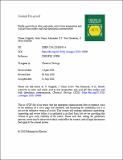Por favor, use este identificador para citar o enlazar a este item:
http://hdl.handle.net/10261/219984COMPARTIR / EXPORTAR:
 SHARE SHARE
 CORE
BASE CORE
BASE
|
|
| Visualizar otros formatos: MARC | Dublin Core | RDF | ORE | MODS | METS | DIDL | DATACITE | |

| Título: | Geochemical and isotopic study of abiotic nitrite reduction coupled to biologically produced Fe(II) oxidation in marine environments |
Autor: | Benaiges-Fernández, Robert CSIC ORCID; Offeddu, Francesco G. CSIC; Margalef-Martí, R.; Palau, Jordi CSIC ORCID; Urmeneta, Jordi; Carrey, Raúl; Otero, Neus CSIC ORCID; Cama, Jordi CSIC ORCID | Palabras clave: | Iron reducing bacteria Chemodenitrification Nitrite reduction Fe(II) oxidation Nitrite isotope |
Fecha de publicación: | dic-2020 | Editor: | Elsevier | Citación: | Chemosphere 260: 127554 (2020) | Resumen: | Estuarine sediments are often characterized by abundant iron oxides, organic matter, and anthropogenic nitrogen compounds (e.g., nitrate and nitrite). Anoxic dissimilatory iron reducing bacteria (e.g., Shewanella loihica) are ubiquitous in these environments where they can catalyze the reduction of Fe(III) (oxyhydr)oxides, thereby releasing aqueous Fe(II). The biologically produced Fe(II) can later reduce nitrite to form nitrous oxide. The effect on nitrite reduction by both biologically produced and artificially amended Fe(II) was examined experimentally. Ferrihydrite was reduced by Shewanella loihica in a batch reaction with an anoxic synthetic sea water medium. Some of the Fe(II) released by S. loihica adsorbed onto ferrihydrite, which was involved in the transformation of ferrihydrite to magnetite. In a second set of experiments with identical medium, no microorganism was present, instead, Fe(II) was amended. The amount of solid-bound Fe(II) in the experiments with bioproduced Fe(II) increased the rate of abiotic NO2− reduction with respect to that with synthetic Fe(II), yielding half-lives of 0.07 and 0.47 d, respectively. The δ18O and δ15N of NO2− was measured through time for both the abiotic and innoculated experiments. The ratio of ε18O/ε15N was 0.6 for the abiotic experiments and 3.1 when NO2− was reduced by S. loihica, thus indicating two different mechanisms for the NO2− reduction. Notably, there is a wide range of the ε18O/ε15N values in the literature for abiotic and biotic NO2− reduction, as such, the use of this ratio to distinguish between reduction mechanisms in natural systems should be taken with caution. Therefore, we suggest an additional constraint to identify the mechanisms (i.e. abiotic/biotic) controlling NO2− reduction in natural settings through the correlation of δ15N-NO2- and the aqueous Fe(II) concentration. | Versión del editor: | https://doi.org/10.1016/j.chemosphere.2020.127554 | URI: | http://hdl.handle.net/10261/219984 | DOI: | 10.1016/j.chemosphere.2020.127554 |
| Aparece en las colecciones: | (IDAEA) Artículos |
Ficheros en este ítem:
| Fichero | Descripción | Tamaño | Formato | |
|---|---|---|---|---|
| Biotite reactivity in nitric and oxalic.pdf | Artículo principal | 7,34 MB | Adobe PDF |  Visualizar/Abrir |
| 1-s2.0-S0045653520317495-mmc1.docx | Material suplementario | 614,08 kB | Microsoft Word XML | Visualizar/Abrir |
CORE Recommender
SCOPUSTM
Citations
10
checked on 30-mar-2024
WEB OF SCIENCETM
Citations
7
checked on 28-feb-2024
Page view(s)
153
checked on 18-abr-2024
Download(s)
105
checked on 18-abr-2024
Google ScholarTM
Check
Altmetric
Altmetric
NOTA: Los ítems de Digital.CSIC están protegidos por copyright, con todos los derechos reservados, a menos que se indique lo contrario.
